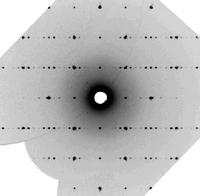
Photo from wikipedia
Abstract According to a general understanding, a crystal structure is defined by a lattice and the content of the unit cell of this lattice. As consequence a crystal exhibits three-dimensional… Click to show full abstract
Abstract According to a general understanding, a crystal structure is defined by a lattice and the content of the unit cell of this lattice. As consequence a crystal exhibits three-dimensional periodicity with respect to the atoms. However, an increasing number of known crystal structures does not follow this idea of periodicity, but shows an aperiodic arrangement of its atoms. This group of so-called “aperiodic crystals” contains quasicrystals, modulated phases and composite structures. The latter two can be properly described within the higher-dimensional superspace approach to enable an accurate crystal-chemical analysis. Here the superspace is a mathematical tool, in which periodicity can be recovered in a higher-dimensional space. In the first part of this review the basic concept of periodic and aperiodic crystals is presented and similarities and differences of modulated phases, composite structures and quasicrystals are discussed. In a second part the higher-dimensional superspace approach is introduced in reciprocal and in direct space and the implementation of symmetry in superspace is reviewed. In the last part representative examples and the origin of aperiodicity in the crystal structures are discussed.
Journal Title: Physical Sciences Reviews
Year Published: 2023
Link to full text (if available)
Share on Social Media: Sign Up to like & get
recommendations!